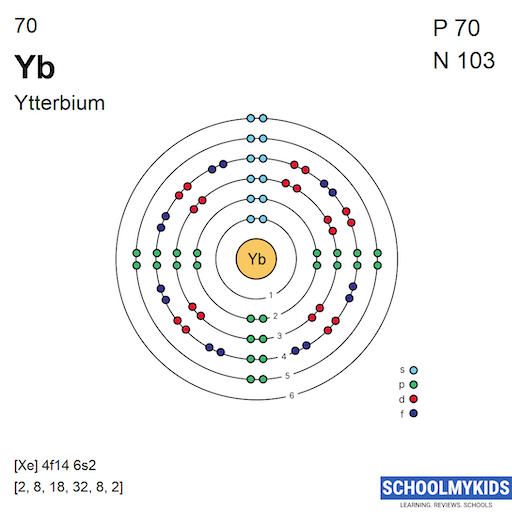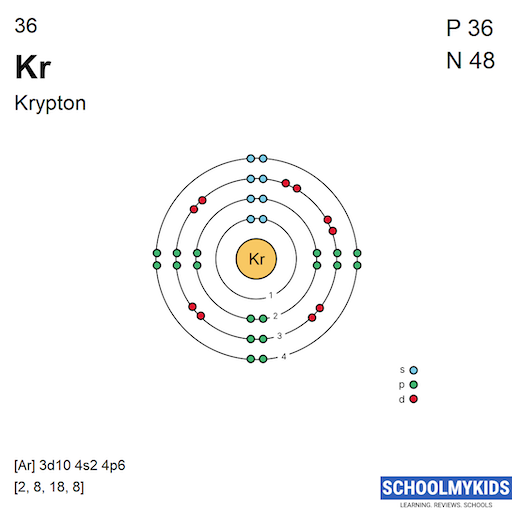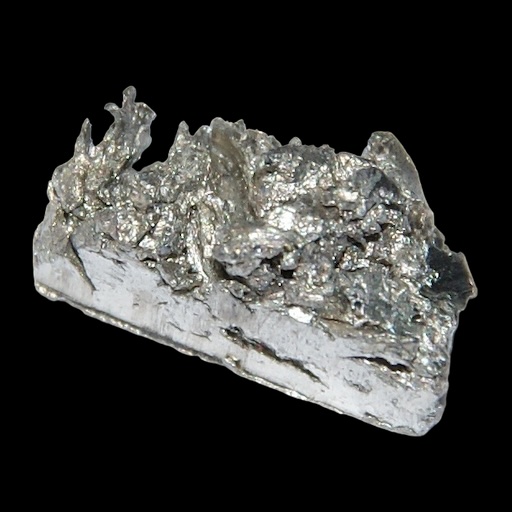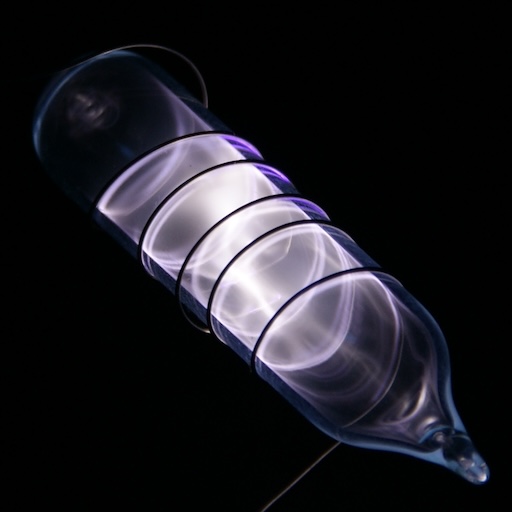Periodic Table Element Comparison: Compare Elements - Ytterbium vs Krypton
Compare Ytterbium and Krypton on the basis of their properties, attributes and periodic table facts. Compare elements on more than 90 properties. All the elements of similar categories show a lot of similarities and differences in their chemical, atomic, physical properties and uses. These similarities and dissimilarities should be known while we study periodic table elements. You can study the detailed comparison between Ytterbium vs Krypton with most reliable information about their properties, attributes, facts, uses etc. You can compare Yb vs Kr on more than 90 properties like electronegativity , oxidation state, atomic shells, orbital structure, Electronaffinity, physical states, electrical conductivity and many more. Ytterbium and Krypton comparison table on more than 90 properties.
Ytterbium and Krypton Comparison
Facts
| Name | Ytterbium | Krypton |
|---|---|---|
| Atomic Number | 70 | 36 |
| Atomic Symbol | Yb | Kr |
| Atomic Weight | 173.04 | 83.798 |
| Phase at STP | Solid | Gas |
| Color | Silver | Colorless |
| Metallic Classification | Lanthanide | Noble Gas |
| Group in Periodic Table | group - | group 18 |
| Group Name | helium family or neon family | |
| Period in Periodic Table | period 6 | period 4 |
| Block in Periodic Table | f -block | p -block |
| Electronic Configuration | [Xe] 4f14 6s2 | [Ar] 3d10 4s2 4p6 |
| Electronic Shell Structure (Electrons per shell) | 2, 8, 18, 32, 8, 2 | 2, 8, 18, 8 |
| Melting Point | 1092 K | 115.79 K |
| Boiling Point | 1469 K | 119.93 K |
| CAS Number | CAS7440-64-4 | CAS7439-90-9 |
| Neighborhood Elements | Neighborhood Elements of Ytterbium | Neighborhood Elements of Krypton |
History
| Parameter | Ytterbium | Krypton |
|---|---|---|
| History | The element Ytterbium was discovered by J.C.G. de Marignac in year 1878 in Switzerland. Ytterbium derived its name from Ytterby, Sweden. | The element Krypton was discovered by W. Ramsay and W. Travers in year 1898 in United Kingdom. Krypton derived its name from the Greek kryptos, meaning 'hidden'. |
| Discovery | J.C.G. de Marignac (1878) | W. Ramsay and W. Travers (1898) |
| Isolated | C. A. von Welsbach (1906) | W. Ramsay and W. Travers (1898) |
Presence: Abundance in Nature and Around Us
Parts per billion (ppb) by weight / by atoms (1ppb =10^-7 %)
| Property | Ytterbium | Krypton |
|---|---|---|
| Abundance in Universe | 2 / 0.01 | 40 / 0.6 |
| Abundance in Sun | 1 / 0.01 | - / - |
| Abundance in Meteorites | 180 / 20 | - / - |
| Abundance in Earth's Crust | 2800 / 340 | 0.15 / 0.04 |
| Abundance in Oceans | 0.0008 / 0.000029 | 0.21 / 0.016 |
| Abundance in Humans | - / - | - / - |
Crystal Structure and Atomic Structure
| Property | Ytterbium | Krypton |
|---|---|---|
| Atomic Volume | 24.84 cm3/mol | 22.35 cm3/mol |
| Atomic Radius | 222 pm | 88 pm |
| Covalent Radius | - | 110 pm |
| Van der Waals Radius | - | 202 pm |
Atomic Spectrum - Spectral Lines | ||
| Emission Spectrum |  |  |
| Absorption Spectrum |  |  |
| Lattice Constant | 548.47, 548.47, 548.47 pm | 570.6, 570.6, 570.6 pm |
| Lattice Angle | π/2, π/2, π/2 | π/2, π/2, π/2 |
| Space Group Name | Fm_ 3m | Fm_ 3m |
| Space Group Number | 225 | 225 |
| Crystal Structure | Face Centered Cubic  | Face Centered Cubic  |
Atomic and Orbital Properties
| Property | Ytterbium | Krypton |
|---|---|---|
| Atomic Number | 70 | 36 |
| Number of Electrons (with no charge) | 70 | 36 |
| Number of Protons | 70 | 36 |
| Mass Number | 173.04 | 83.798 |
| Number of Neutrons | 103 | 48 |
| Shell structure (Electrons per energy level) | 2, 8, 18, 32, 8, 2 | 2, 8, 18, 8 |
| Electron Configuration | [Xe] 4f14 6s2 | [Ar] 3d10 4s2 4p6 |
| Valence Electrons | 4f14 6s2 | 4s2 4p6 |
| Oxidation State | 3 | 0 |
| Atomic Term Symbol (Quantum Numbers) | 1S0 | 1S0 |
| Shell structure |  |  |
Isotopes and Nuclear Properties
Ytterbium has 7 stable naturally occuring isotopes while Krypton has 6 stable naturally occuring isotopes.
| Parameter | Ytterbium | Krypton |
|---|---|---|
| Known Isotopes | 148Yb, 149Yb, 150Yb, 151Yb, 152Yb, 153Yb, 154Yb, 155Yb, 156Yb, 157Yb, 158Yb, 159Yb, 160Yb, 161Yb, 162Yb, 163Yb, 164Yb, 165Yb, 166Yb, 167Yb, 168Yb, 169Yb, 170Yb, 171Yb, 172Yb, 173Yb, 174Yb, 175Yb, 176Yb, 177Yb, 178Yb, 179Yb, 180Yb, 181Yb | 69Kr, 70Kr, 71Kr, 72Kr, 73Kr, 74Kr, 75Kr, 76Kr, 77Kr, 78Kr, 79Kr, 80Kr, 81Kr, 82Kr, 83Kr, 84Kr, 85Kr, 86Kr, 87Kr, 88Kr, 89Kr, 90Kr, 91Kr, 92Kr, 93Kr, 94Kr, 95Kr, 96Kr, 97Kr, 98Kr, 99Kr, 100Kr |
| Stable Isotopes | Naturally occurring stable isotopes: 168Yb, 170Yb, 171Yb, 172Yb, 173Yb, 174Yb, 176Yb | Naturally occurring stable isotopes: 78Kr, 80Kr, 82Kr, 83Kr, 84Kr, 86Kr |
| Neutron Cross Section | 35 | 25 |
| Neutron Mass Absorption | 0.0076 | 0.013 |
Chemical Properties: Ionization Energies and electron affinity
| Property | Ytterbium | Krypton |
|---|---|---|
| Valence or Valency | 3 | 2 |
| Electronegativity | 1.1 Pauling Scale | 3 Pauling Scale |
| Electron Affinity | 50 kJ/mol | 0 kJ/mol |
| Ionization Energies | 1st: 603.4 kJ/mol 2nd: 1174.8 kJ/mol 3rd: 2417 kJ/mol 4th: 4203 kJ/mol | 1st: 1350.8 kJ/mol 2nd: 2350.4 kJ/mol 3rd: 3565 kJ/mol 4th: 5070 kJ/mol 5th: 6240 kJ/mol 6th: 7570 kJ/mol 7th: 10710 kJ/mol 8th: 12138 kJ/mol 9th: 22274 kJ/mol 10th: 25880 kJ/mol 11th: 29700 kJ/mol 12th: 33800 kJ/mol 13th: 37700 kJ/mol 14th: 43100 kJ/mol 15th: 47500 kJ/mol 16th: 52200 kJ/mol 17th: 57100 kJ/mol 18th: 61800 kJ/mol 19th: 75800 kJ/mol 20th: 80400 kJ/mol 21st: 85300 kJ/mol 22nd: 90400 kJ/mol 23rd: 96300 kJ/mol 24th: 101400 kJ/mol 25th: 111100 kJ/mol 26th: 116290 kJ/mol 27th: 282500 kJ/mol 28th: 296200 kJ/mol 29th: 311400 kJ/mol 30th: 326200 kJ/mol |
Physical Properties
| Property | Ytterbium | Krypton |
|---|---|---|
| Density | 6.57 g/cm3 | 0.00375 g/cm3 |
| Molar Volume | 24.84 cm3/mol | 22.35 cm3/mol |
Elastic Properties | ||
| Young Modulus | 24 | - |
| Shear Modulus | 9.9 GPa | - |
| Bulk Modulus | 31 GPa | - |
| Poisson Ratio | 0.21 | - |
Hardness - Tests to Measure of Hardness of Element | ||
| Mohs Hardness | - | - |
| Vickers Hardness | 206 MPa | - |
| Brinell Hardness | 343 MPa | - |
Electrical Properties | ||
| Electrical Conductivity | 3600000 S/m | - |
| Resistivity | 2.79e-7 m Ω | - |
| Superconducting Point | - | - |
Heat and Conduction Properties | ||
| Thermal Conductivity | 39 W/(m K) | 0.00943 W/(m K) |
| Thermal Expansion | 0.0000263 /K | - |
Magnetic Properties | ||
| Magnetic Type | Paramagnetic | Diamagnetic |
| Curie Point | - | - |
| Mass Magnetic Susceptibility | 5.9e-9 m3/kg | -4.4e-9 m3/kg |
| Molar Magnetic Susceptibility | 1.02e-9 m3/mol | -3.69e-10 m3/mol |
| Volume Magnetic Susceptibility | 0.0000388 | -1.65e-8 |
Optical Properties | ||
| Refractive Index | - | 1.000427 |
Acoustic Properties | ||
| Speed of Sound | 1590 m/s | 1120 m/s |
Thermal Properties - Enthalpies and thermodynamics
| Property | Ytterbium | Krypton |
|---|---|---|
| Melting Point | 1092 K | 115.79 K |
| Boiling Point | 1469 K | 119.93 K |
| Critical Temperature | - | 209.41 K |
| Superconducting Point | - | - |
Enthalpies | ||
| Heat of Fusion | 7.7 kJ/mol | 1.64 kJ/mol |
| Heat of Vaporization | 160 kJ/mol | 9.02 kJ/mol |
| Heat of Combustion | - | - |
Regulatory and Health - Health and Safety Parameters and Guidelines
| Parameter | Ytterbium | Krypton |
|---|---|---|
| CAS Number | CAS7440-64-4 | CAS7439-90-9 |
| RTECS Number | RTECSZG1925000 | RTECSOC6772500 |
| DOT Hazard Class | - | 2.2 |
| DOT Numbers | - | 1970 |
| EU Number | - | EU231-098-5 |
| NFPA Fire Rating | - | - |
| NFPA Health Rating | - | - |
| NFPA Reactivity Rating | - | - |
| NFPA Hazards | - | - |
| AutoIgnition Point | - | - |
| Flashpoint | - | - |
Compare With Other Elements
Compare Ytterbium and Krypton with other elements of the periodic table.

